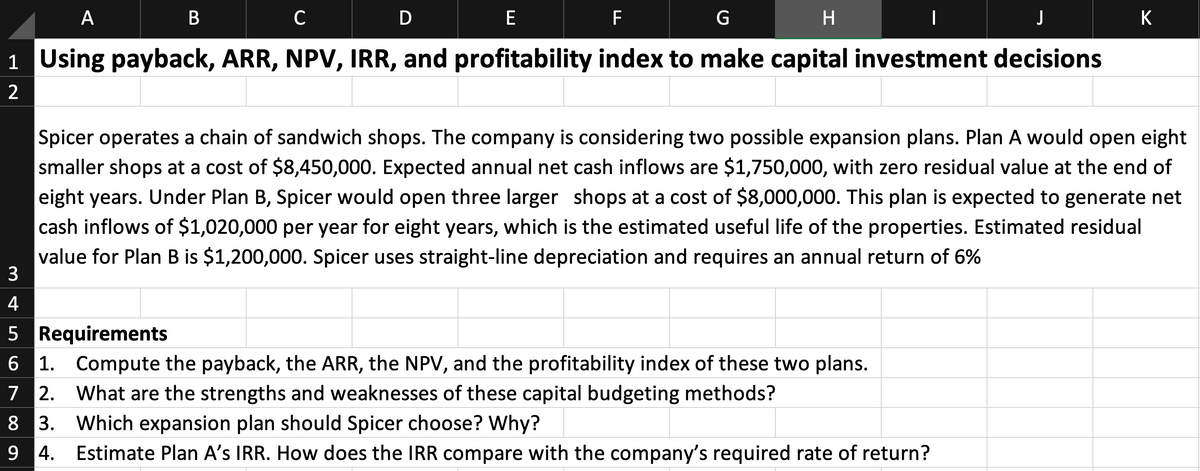Using payback, ARR, NPV, IRR, and profitability index to make capital investment decisions Spicer operates a chain of sandwich shops. The company is considering two possible expansion plans. Plan A would open eight smaller shops at a cost of $8,450,000. Expected annual net cash inflows are $1,750,000, with zero residual value at the end of eight years. Under Plan B, Spicer would open three larger shops at a cost of $8,000,000. This plan is expected to generate net cash inflows of $1,020,000 per year for eight years, which is the estimated useful life of the properties. Estimated residual value for Plan B is $1,200,000. Spicer uses straight-line depreciation and requires an annual return of 6% Requirements 1. Compute the payback, the ARR, the NPV, and the profitability index of these two plans. 2. What are the strengths and weaknesses of these capital budgeting methods? 3. Which expansion plan should Spicer choose? Why? 4. Estimate Plan A's IRR. How does the IRR compare with the company's required rate of return?
Using payback, ARR, NPV, IRR, and profitability index to make capital investment decisions Spicer operates a chain of sandwich shops. The company is considering two possible expansion plans. Plan A would open eight smaller shops at a cost of $8,450,000. Expected annual net cash inflows are $1,750,000, with zero residual value at the end of eight years. Under Plan B, Spicer would open three larger shops at a cost of $8,000,000. This plan is expected to generate net cash inflows of $1,020,000 per year for eight years, which is the estimated useful life of the properties. Estimated residual value for Plan B is $1,200,000. Spicer uses straight-line depreciation and requires an annual return of 6% Requirements 1. Compute the payback, the ARR, the NPV, and the profitability index of these two plans. 2. What are the strengths and weaknesses of these capital budgeting methods? 3. Which expansion plan should Spicer choose? Why? 4. Estimate Plan A's IRR. How does the IRR compare with the company's required rate of return?
Managerial Accounting
15th Edition
ISBN:9781337912020
Author:Carl Warren, Ph.d. Cma William B. Tayler
Publisher:Carl Warren, Ph.d. Cma William B. Tayler
Chapter12: Capital Investment Analysis
Section: Chapter Questions
Problem 6E: Cash payback method Lily Products Company is considering an investment in one of two new product...
Related questions
Question
I need 4

Transcribed Image Text:A
D
E
F
K
1 Using payback, ARR, NPV, IRR, and profitability index to make capital investment decisions
2
Spicer operates a chain of sandwich shops. The company is considering two possible expansion plans. Plan A would open eight
smaller shops at a cost of $8,450,000. Expected annual net cash inflows are $1,750,000, with zero residual value at the end of
eight years. Under Plan B, Spicer would open three larger shops at a cost of $8,000,000. This plan is expected to generate net
cash inflows of $1,020,000 per year for eight years, which is the estimated useful life of the properties. Estimated residual
value for Plan B is $1,200,000. Spicer uses straight-line depreciation and requires an annual return of 6%
3
4
5 Requirements
6 1. Compute the payback, the ARR, the NPV, and the profitability index of these two plans.
7 2. What are the strengths and weaknesses of these capital budgeting methods?
8 3. Which expansion plan should Spicer choose? Why?
9 4. Estimate Plan A's IRR. How does the IRR compare with the company's required rate of return?
Expert Solution
This question has been solved!
Explore an expertly crafted, step-by-step solution for a thorough understanding of key concepts.
This is a popular solution!
Trending now
This is a popular solution!
Step by step
Solved in 5 steps

Knowledge Booster
Learn more about
Need a deep-dive on the concept behind this application? Look no further. Learn more about this topic, accounting and related others by exploring similar questions and additional content below.Recommended textbooks for you

Managerial Accounting
Accounting
ISBN:
9781337912020
Author:
Carl Warren, Ph.d. Cma William B. Tayler
Publisher:
South-Western College Pub


Cornerstones of Financial Accounting
Accounting
ISBN:
9781337690881
Author:
Jay Rich, Jeff Jones
Publisher:
Cengage Learning

Managerial Accounting
Accounting
ISBN:
9781337912020
Author:
Carl Warren, Ph.d. Cma William B. Tayler
Publisher:
South-Western College Pub


Cornerstones of Financial Accounting
Accounting
ISBN:
9781337690881
Author:
Jay Rich, Jeff Jones
Publisher:
Cengage Learning


Financial And Managerial Accounting
Accounting
ISBN:
9781337902663
Author:
WARREN, Carl S.
Publisher:
Cengage Learning,

Managerial Accounting: The Cornerstone of Busines…
Accounting
ISBN:
9781337115773
Author:
Maryanne M. Mowen, Don R. Hansen, Dan L. Heitger
Publisher:
Cengage Learning